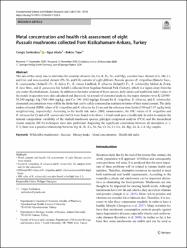Metal concentration and health risk assessment of eight Russula mushrooms collected from Kizilcahamam-Ankara, Turkey
| dc.contributor.author | Sarıkürkçü, Cengiz | |
| dc.contributor.author | Akata, Ilgaz | |
| dc.contributor.author | Tepe, Bektaş | |
| dc.date.accessioned | 2021-05-05T22:14:05Z | |
| dc.date.available | 2021-05-05T22:14:05Z | |
| dc.date.issued | 2021 | |
| dc.identifier.issn | 0944-1344 | |
| dc.identifier.issn | 1614-7499 | |
| dc.identifier.uri | https://doi.org/10.1007/s11356-020-11833-6 | |
| dc.identifier.uri | https://hdl.handle.net/20.500.12933/272 | |
| dc.description | Sarikurkcu, Cengiz/0000-0001-5094-2520 | en_US |
| dc.description | WOS:000593014400004 | en_US |
| dc.description | PubMed: 33244695 | en_US |
| dc.description.abstract | The aim of this study was to determine the essential element (Zn, Ca, K, Fe, Na, and Mg), essential trace element (Co, Mn, Cr, and Cu), and non-essential element (Pb, Ni, and Cd) contents of eight different Russula species (R. risigallina (Batsch) Sacc., R. cyanoxantha (Schaeff.) Fr., R. delica Fr., R. vinosa Lindblad, R. olivacea (Schaeff.) Fr., R. velenovskyi Melzer & Zvara, R. turci Bres., and R. parazurea Jul. Schaff.) collected from Soguksu National Park (Turkey), which is a region away from the city center (Kizilcahamam, Ankara). In addition to the metal contents of these species, daily intake and health risk index values of the metals in question were also calculated and discussed. As a result of elemental analysis, the major elements were K (28980-58,380 mg/kg), Mg (704-1404 mg/kg), and Ca (190-1662 mg/kg). Except for R. risigallina, R. olivacea, and R. velenovskyi, elemental concentrations were within the limits that can be safely consumed as nutrients in terms of their metal content. The daily intakes of metal (DIM) values of R. risigallina and R. olivacea for Cr exceed the reference dose limits (3.80 and 3.87 mu g/kg body weight/serving, respectively). According to the health risk index (HRI) measurements, the HRI values of R. risigallina and R. olivacea for Cr and of R. velenovskyi for Cd were found to be above 1.0 and could pose a health risk. In order to analyze the mineral composition variability of the studied mushroom species, principal component analysis (PCA) and the hierarchical cluster analysis (HCA) techniques were also performed. Regarding the significant correlations between all descriptors (r > 0.7), there was a positive relationship between Mg-K, Ni-Co, Ni-Na, Cr-Ni, Cr-Co, Zn-Mg, Zn-K, Cd-Mg couples. | en_US |
| dc.language.iso | eng | en_US |
| dc.publisher | Springer Heidelberg | en_US |
| dc.rights | info:eu-repo/semantics/openAccess | en_US |
| dc.subject | Wild edible mushrooms | en_US |
| dc.subject | Russula | en_US |
| dc.subject | Dietary intake | en_US |
| dc.subject | Metal concentration | en_US |
| dc.subject | Health risk index | en_US |
| dc.title | Metal concentration and health risk assessment of eight Russula mushrooms collected from Kizilcahamam-Ankara, Turkey | en_US |
| dc.type | article | en_US |
| dc.department | AFSÜ, Eczacılık Fakültesi, Temel Eczacılık Bilimleri Bölümü | en_US |
| dc.contributor.institutionauthor | Sarıkürkçü, Cengiz | |
| dc.identifier.doi | 10.1007/s11356-020-11833-6 | |
| dc.identifier.volume | 28 | en_US |
| dc.identifier.issue | 13 | en_US |
| dc.identifier.startpage | 15743 | en_US |
| dc.identifier.endpage | 15754 | en_US |
| dc.relation.journal | Environmental Science And Pollution Research | en_US |
| dc.relation.publicationcategory | Makale - Uluslararası Hakemli Dergi - Kurum Öğretim Elemanı | en_US |
Bu öğenin dosyaları:
Bu öğe aşağıdaki koleksiyon(lar)da görünmektedir.
-
PubMed İndeksli Yayınlar Koleksiyonu [555]
PubMed Indexed Publications Collection -
Scopus İndeksli Yayınlar Koleksiyonu [512]
Scopus Indexed Publications Collection -
WoS İndeksli Yayınlar Koleksiyonu [504]
WoS Indexed Publications Collection
















